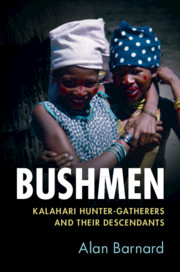Book contents
- Bushmen
- Bushmen
- Copyright page
- Contents
- Figures
- Tables
- Preface
- Pronunciation and Orthography
- 1 Bushmen
- 2 The Politics of Indigeneity
- 3 How Far Back Can We Go?
- 4 Discovery and Destruction of the /Xam
- 5 The !Xoõ and Their Neighbours
- 6 G/wi, G//ana and the Central Kalahari
- 7 Naro
- 8 Ju/’hoansi or !Kung
- 9 Hai//om
- 10 Bushmen of the Okavango
- 11 Sharing the Land with Others
- 12 Conclusions
- References
- Index
- References
4 - Discovery and Destruction of the /Xam
Published online by Cambridge University Press: 11 July 2019
- Bushmen
- Bushmen
- Copyright page
- Contents
- Figures
- Tables
- Preface
- Pronunciation and Orthography
- 1 Bushmen
- 2 The Politics of Indigeneity
- 3 How Far Back Can We Go?
- 4 Discovery and Destruction of the /Xam
- 5 The !Xoõ and Their Neighbours
- 6 G/wi, G//ana and the Central Kalahari
- 7 Naro
- 8 Ju/’hoansi or !Kung
- 9 Hai//om
- 10 Bushmen of the Okavango
- 11 Sharing the Land with Others
- 12 Conclusions
- References
- Index
- References
Summary
Thanks to the pioneering work of the Bleek family, /Xam were the first Bushman group to gain fame. This period of research began in 1870, in South Africa, with the leading publication in 1911. The emphasis was on language and on folklore, and subsequent work on tiny groups such as the /’Auni, ≠Khomani, //Xegwi and N//ŋ (sadly, all now long gone) pretty much completed the ethnographic understanding of ‘Southern Bushman’ culture. This chapter will cover these groups. I will attempt to discuss their importance in light of the subsequent growth of Bushman studies in the late twentieth century and in the twenty-first: work by Andrew Banks, Mark McGranahgan, Michael Wessels and Shane Moran. The /Xam may have shot to fame in the nineteenth century, but in the last decade or so have achieved great notoriety thanks to a resurgence of academic interest, and possibly because the new motto of the Republic of South Africa is in the /Xam language.
Keywords
- Type
- Chapter
- Information
- BushmenKalahari Hunter-Gatherers and Their Descendants, pp. 56 - 72Publisher: Cambridge University PressPrint publication year: 2019

